Christianity in Norway
Christianity is the largest religion in Norway. Norway has historically been called a Christian country. A majority of the population are members of the Church of Norway with 69.9% of the population officially belonging to the Evangelical Lutheran Church of Norway in 2018.[1] At numerous times in history, Norway sent more missionaries per capita than any other country. This changed considerably from the 1960s. In 2004, only 12% of the population attended church services each month.[2] Citizens born in Norway to one or two Norwegian parents are automatically added to the list of Protestant Christians in Norway, and are required to "sign out" of the church. There are two categories kept in the church's books, "medlemmer" (members) and "tilhørige" (belonging to [the State church]). Members technically have to be baptised, whereas "tilhørige" are to be taken out of the books if not baptised by the age of 18. Norwegian citizens' tax funds are given to the Protestant Church until one registers as a member of another religious group, or as a member of the Humanist association.[3]
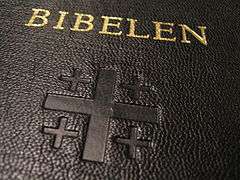
In 1993, there were 4,981 churches and chapels in Norway.[4]
Christianization

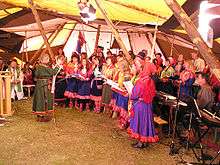
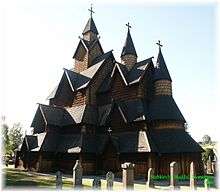
The conversion of Norway to Christianity began in 1000 AD. The raids on Ireland, Britain and the Frankish kingdoms had brought the Vikings in touch with Christianity. Haakon the Good of Norway who had grown up in England tried to introduce Christianity in the tenth century, but had met resistance from pagan leaders and soon abandoned the idea.
Anglo-Saxon missionaries from England and Germany engaged in converting Norwegians to Christianity, but with limited success. However, they succeeded in converting Olaf I of Norway to Christianity. Olaf II of Norway (later Saint Olaf) had more success in his efforts to convert the population, and he is credited with Christianising Norway.
The Christians in Norway often established churches or other holy sites at places that had previously been sacred under the Norse religion. The spread of conversion can be measured by burial sites as Pagans were buried with grave goods while Christians weren't. Christianity had become well established in Norway by the middle of the 11th century and had become dominant by the middle of the 12th century. Stave churches were built of wood without the use of nails in the 13th century.
By county
| County | Christians[5][6] |
|---|---|
| 90.4% | |
| 90.2% | |
| 89.9% | |
| 89.6% | |
| 89.2% | |
| 89.1% | |
| 88.9% | |
| 88.8% | |
| 87.5% | |
| 86.6% | |
| 85.6% | |
| 85.4% | |
| 84.8% | |
| 84.6% | |
| 84.2% | |
| 83.0% | |
| 81.4% | |
| 65.8% |
The above numbers reflect the percentage of the population that are members of a church, typically from being baptized as infants. According to study collected on a sample of 706 Less than half of these define themselves as Christian.[7]
Compared with other countries
Church attendance
Early 21st century, Norway had one of the lowest church attendance rates in the world. Below is a table that compares Norway with other governmental divisions in regular church attendance for the early 21st century (2004–2006). In contrast to 250,000 regular churchgoers in the whole of Norway in 2004, 43,500 attend Lakewood Church in the United States each week, and 23,000 attend Hillsong Church in Australia each week.
The U.S. state of Alabama has a population roughly equal to that of Norway, but church attendance in Alabama is as much as 11 times higher than in Norway.
| Country / State | Regular church attendance (%) | Regular church attendance (number) |
|---|---|---|
| 58%[8] | 2,700,000 | |
| 56.7%[9] | 21,600,000 | |
| 49%[8] | 12,140,000 | |
| 42%[8] | 120,000,000 | |
| 32%[8] | 11,830,000 | |
| 25% | 7,800,000 | |
| 24%[8] | 140,000 | |
| 15% | 9,800,000 | |
| 10%[10] | 6,000,000 | |
| 7.5%[11] | 1,500,000 | |
| 5%[12] | 250,000 |
Importance of religion
Below is a table that compares Norway with other countries in importance of religion.
| Country | People who say religion is important[13] | Percent Christian of total population (%) |
|---|---|---|
| 98.5% | 95.1% | |
| 95.5% | 92.4% | |
| 86.5% | 90.4% | |
| 82.5% | 2.0% | |
| 75% | 98.1% | |
| 71.5% | 98.0% | |
| 53.5% | 92.3% | |
| 42.5% | 34.6% | |
| 32.5% | 20.0% | |
| 28% | 82.2% | |
| 20.5% | 85.6% | |
| 18% | 89.4% | |
| 16.5% | 79.9% | |
| 16% | 27.8% |
Public opinion
World Values Survey
| Religious Affiliation/Identification | 1982 | 1990 | 1996 | 2005 |
|---|---|---|---|---|
| Percent belonging to a religious denomination | 95.9% | 90.2% | 90.7% | -- |
| Percent identifying as a religious person | 48% | 47.5% | 46.9% | 41.3% |
| Percent raised religious | -- | 45.7% | 41.4% | -- |
| Religious Behaviors | 1982 | 1990 | 1996 | 2005 |
|---|---|---|---|---|
| Percent attending religious services at least once a month | 15.4% | 12.7% | 12.5% | 10.8% |
| Percent that meditate or pray | 61.6% | 64.4% | -- | 33.2% |
| Percent active in a church or religious organization | -- | -- | 8.3% | 8.3% |
| Religious Beliefs | 1982 | 1990 | 1996 | 2005 |
|---|---|---|---|---|
| Percent believing in God | 75.5% | 65% | 68.8% | -- |
| Percent believing in heaven | 51.9% | 43.8% | 46.7% | -- |
| Percent believing in hell | 23.5% | 19.2% | 19.7% | -- |
| Percent believing in life after death | 50.7% | 44.7% | 47.3% | -- |
| Percent believing that there are clear guidelines on good and evil | 31.4% | 31.6% | 29.1% | -- |
| Percent believing that politicians who do not believe in God are unfit for public office | -- | -- | -- | 3.8% |
| Percent believing that religious leaders should not influence people's vote | -- | -- | -- | 8.9% |
| Percent believing that things would be better if there are more people with strong religious beliefs | -- | -- | -- | 6.2% |
| Percent believing church gives answers to people's spiritual needs | 64.3% | 55% | -- | 48.2% |
| Percent believing church gives answers on family life problems | 36.5% | 29.1% | -- | 16.1% |
| Percent believing churches give answers to moral problems | 47.5% | 40.9% | -- | 28.7% |
| Percent believing churches give answers to social problems | -- | 18.5% | -- | 11.7% |
| Percent believing that religious leaders should influence the government | -- | -- | -- | 79.4% |
| Percent believing that people have a soul | 59% | 54.4% | 59.6% | -- |
| Percent believing in the concept of sin | 59.2% | 44.2% | 45.4% | -- |
| Percent believing religious services are important for deaths | -- | 81.1% | -- | -- |
| Percent believing religious services are important for births | -- | 66.3% | -- | -- |
| Percent believing religious services are important for marriages | -- | 70.4% | -- | -- |
| Percent believing in a personal God | 39.2% | 29.8% | -- | -- |
| Percent believing in re-incarnation | 38.4% | 15.2% | -- | -- |
| Percent believing in the devil's existence | 30.2% | 24% | 28% | -- |
| Percent that think that religious faith is an important quality in children | -- | -- | -- | 8.6% |
| Percent that agree: We depend too much on science and not enough on faith | -- | -- | -- | 25.8% |
| Percent that do not trust people of other religions | -- | -- | -- | 20.4% |
| Percent that often think about meaning and purpose of life | -- | -- | -- | 20.2% |
| Religious Experiences | 1982 | 1990 | 1996 | 2005 |
|---|---|---|---|---|
| Percent finding comfort and strength from religion | 48.5% | 35.6% | 39.5% | -- |
| Attitudes | 1982 | 1990 | 1996 | 2005 |
|---|---|---|---|---|
| Percent considering religion important | -- | 40.3% | 38.2% | 32.8% |
| Percent considering that God is not at all important in their life | 19.6% | 24.8% | 22.1% | 27.9% |
| Percent confident in religious organizations | 49.6% | 44.6% | 53.5% | 50.5% |
Other
| Born again Christian[14] | 1997 | 2010 |
|---|---|---|
| Percent who report Born-again Christian | 19% | 26% |
| People who report Born-again Christian | 835,000 | 1,263,000 |
Denominations
Statistics Norway
| Religion (in 31.12.2018)[1][15] | Members | Percent | Growth (2013–2018) |
|---|---|---|---|
| Christianity | 4,090,708 | 76.77% | -2.2% |
| Church of Norway | 3,724,857 | 69.91% | -3.1% |
| Catholic Church | 160,884[16] | 3.02% | 14.8% |
| Pentecostal congregations | 40,632 | 0.76% | 3.1% |
| Eastern Orthodoxy and Oriental Orthodoxy | 27,034 | 0.51% | 83.1% |
| Evangelical Lutheran Free Church | 19,500 | 0.37% | -0.3% |
| Jehovah's Witnesses | 12,680 | 0.24% | 4.5% |
| Baptists | 10,731 | 0.20% | 4.4% |
| The Methodist Church in Norway | 10,190 | 0.19% | -4.6% |
| Other Christianity | 84,200 | 1.58% | -6.8% |
| Total[17] | 5,328,212 | 100.0% | 4.3% |
The Association of Religion Data Archives
| Denomination | Percent[18] |
|---|---|
| Christian | 92.0% |
| Agnostic | 3.5% |
| Muslim | 2.8% |
| Buddhist | 0.7% |
| Atheist | 0.6% |
| Baha'i | 0.1% |
| Neo-pagan | 0.1% |
Operation World 2001
| Denomination | Percent[19] |
|---|---|
| Christianity | 93.7% |
| Protestant | 89.4% |
| Other Christian | 2.0% |
| Independent | 1.2% |
| Catholic | 0.8% |
| Non-religious | 5.0% |
| Islam | 1.0% |
| Buddhism | 0.2% |
| Christianity by country |
|---|
 |
|
|
|
|
Oceania
|
|
South America
|
|
|
Protestantism
Lutheranism
Church of Norway
The Church of Norway (Den norske kirke in Bokmål or Den norske kyrkja in Nynorsk) is the state church of Norway. The church confesses the Lutheran Christian faith. It has as its foundation the Christian Bible, the Apostles' Creed, Nicene Creed, Athanasian Creed, Luther's Small Catechism and the Augsburg Confession. The Church is a member of the Porvoo Communion with 12 other churches, among them the Anglican Churches of Europe. It has also signed some other ecumenical texts, including the Joint Declaration on the Doctrine of Justification with the Catholic Church.
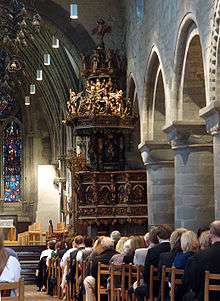
The constitutional head of the Church is the King of Norway, who is obliged to profess the Lutheran faith. The Church of Norway is subject to legislation, including its budgets, passed by the Norwegian parliament, the Storting, and its central administrative functions are carried out by the Royal Ministry of Culture and Church Affairs.
The Church has a congregational and episcopal structure, with 1,284 parishes, 106 deaneries and 11 dioceses, namely:
- Oslo, seated in Oslo, also covers Asker and Bærum (Bishop Ole Christian Kvarme)
- Borg, seated in Fredrikstad covering areas southeast of Oslo (Bishop Helga Haugland Byfuglien)
- Hamar, seated in Hamar covering most of the inland areas north and east of Oslo (Bishop Solveig Fiske)
- Tunsberg, seated in Tønsberg covering coastal areas just southwest of Oslo and inland northwest (Bishop Laila Riksaasen Dahl)
- Agder og Telemark, seated in Kristiansand covering Southeastern Norway (Bishop Olav Skjevesland)
- Stavanger, seated in Stavanger covering Southwestern Norway (Bishop Erling Pettersen)
- Bjørgvin, seated in Bergen covering parts of Western Norway (Bishop Halvor Nordhaug)
- Møre, seated in Molde covering northern parts of Western Norway (Bishop Ingeborg Midttømme)
- Nidaros, seated in Trondheim, covering Trøndelag (Bishop Tor Singsaas)
- Sør-Hålogaland, seated in Bodø, covering southern areas of Northern Norway (Bishop Tor Berger Jørgensen)
- Nord-Hålogaland, seated in Tromsø, covering the rest of Northern Norway (Bishop Per Oskar Kjølaas)
| As of 2008[20] | Percent | |
|---|---|---|
| Members | 3,874,823 | 81.8% |
| Participation in worship services, Sundays and holidays | 5,069,341 | |
| Baptism | 42,599 | |
| Confirmation | 41,655 | |
| Consecration | 10,536 | |
| Funeral | 38,832 |
Evangelical Lutheran Free Church of Norway
The Evangelical Lutheran Free Church of Norway (Den Evangelisk Lutherske frikyrkja i Noreg in Norwegian) or the Free Church as it is commonly known, is a nationwide Lutheran church in Norway consisting of 81 congregations with 19,262 members in 2009.[21] It was founded in 1877 in Moss. It should not be confused with the Church of Norway, though both churches are members of the Lutheran World Federation. The Free Church is economically independent.
The following numbers is from :[21]
The Swedish Margareta Congregation in Oslo
15,574 members in 2009, up from 7,267 in 2005.
Det norske misjonsforbund
8,497 members in 2009, down from 8,505 in 2005.
The Christian Community
6,779 members in 2009, up from 6,054 in 2005.
The Finnish Evangelical Lutheran Congregation
4,237 members in 2009, up from 3,504 in 2005.
Free Evangelical Congregations
3,434 members in 2009, down from 3,653 in 2005.
Christian Centres
3,290 members in 2009, up from 3,264 in 2005.
The Evangelical Lutheran Church Community
3,232 members in 2009, down from 3,410 in 2005.
The Icelandic Evangelical Lutheran Congregation in Norway
2,735 members in 2009, down from 3,395 in 2005.
The Christian Community
2,474 members in 2009, up from 2,472 in 2006.
Pentecostalism
Baptism
Brunstad Christian Church
Brunstad Christian Church is the largest international Christian movement founded in Norway.
Adventism
Anglicanism
Methodism
The Methodist Church of Norway had 10,974 members in 2009, down from 11,981 in 2005.[21]
Catholic Church
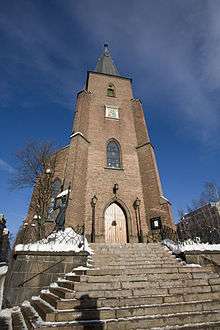
The Catholic Church in Norway is part of the worldwide Catholic Church, under the spiritual leadership of the Pope and the Curia in Rome. Per 15 October 2012 the church had 115, 234 registered members. The number has increased from 59, 350 in 2008 due to high immigration. There may be approximately 170,000–200,000 people of Catholic background in the country, most of them immigrants.[22]
The country is divided into three Church districts – the Diocese of Oslo and the prelatures of Trondheim and Tromsø and 32 parishes. The Bishop of Oslo participates in the Scandinavian Bishops Conference. The Catholic Church in Norway is as old as the kingdom itself, dating from approximately 900 A.D., with the first Christian monarchs, Haakon I from 934.
At first, the bulk of Catholic immigrants came from Germany, The Netherlands, and France. Immigration from Chile, the Philippines, and from a wide range of other countries began in the 1970s. This development has further increased in the last few years with economic immigrants from Poland and Lithuania. Ethnic Norwegian Catholics are now greatly outnumbered by the immigrants, although the former tend to be far more observant and conservative, being a self-selected group largely of ex-Lutheran converts.
Eastern Orthodoxy
Oriental Orthodoxy
Restorationism
Jehovah's Witnesses
Jehovah's Witnesses is the largest nontrinitarian religious organization in Norway, with a membership of 14,976 in 2009.[23] A branch office is located in Ytre Enebakk. Jehovah's Witnesses receive public grants in the same manner as other registered religious communities in Norway.
Mormonism
See also
References
- Church of Norway Statistics Norway 14.5.2019
- Norsk samfunnsvitenskapelig datatjeneste – Få nordmenn i kirken, men ikke færre enn før
- "Startside kirken.no".
- "Hvor mange aktive kristne finnes i Norge?". Archived from the original on 24 July 2011. Retrieved 21 July 2010.
- Statistics Norway – Church of Norway.
- Statistics Norway – Members of religious and life stance communities outside the Church of Norway, by religion/life stance. County. 2006–2010 Archived 2 November 2011 at the Wayback Machine
- Flertallet av kirkemedlemmene er ikke kristne
- "San Diego Times, May 2, 2006, from 2006 Gallup survey".
- "Polish lead EU in Sunday church attendance".
- "'One in 10' attends church weekly". BBC News.
- NCLS releases latest estimates of church attendance], National Church Life Survey, Media release,
- "NorgeIDAG – Hvor mange aktive kristne finnes i Norge?". Archived from the original on 24 July 2011. Retrieved 21 July 2010.
- GALLUP WorldView – data. Retrieved 17 January 2009
- "Sterk økning i personlige kristne". Archived from the original on 18 July 2011. Retrieved 5 September 2010.
- Members of Christian communities outside the Church of Norway. Statistics Norway 3.12.2019
- In 2015 the bishop of the Diocese of Oslo, Bernt Ivar Eidsvig, and his financial manager were charged with fraud for adding up to 65,000 extra names to the Catholic membership list over the previous several years.Gaffey, Conor (2 July 2015). "Catholic Church accused of defrauding Norway of €5.7m". Newsweek. Retrieved 3 July 2015.
- Population Statistics Norway
- The Association of Religion Data Archives
- Joshua Project – Religions
- Kirkedatabasen
- "Statistics Norway". Archived from the original on 22 February 2013. Retrieved 14 January 2010.
- Andreas Slettholm: Nå er det flere katolikker enn muslimer i Norge Aftenposten, 3 December 2012
- Statistics Norway